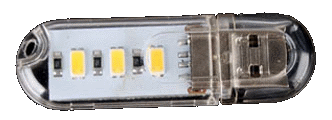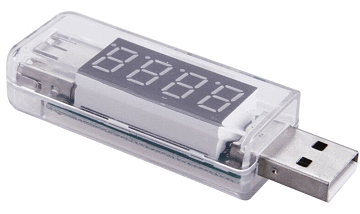You Are Here: Greyghost > Product Reviews > Mini USB 3 LED Lamp Review
Mini USB 3 LED Lamp Review
Rating: 
Remember when white LEDs first
hit the market? Even after they were on the market for a while, they
remained a fairly expensive novelty, especially as compared to the more
traditional colors and even the blue LEDs upon which they were based.
My, how things have changed. White LEDs today are finding applications
in practical incandescent light bulb replacements and many electronic
devices with LED indicators will have at least one that glows white.
The prices have also fallen through the floor.
At ninety-nine cents apiece including shipping
for a light like the one shown above, oh boy have they ever. I bought
five, because at that kind of price, who cares if they aren't that
great? (In case you're wondering and just can't wait...these things
actually do seem to be pretty decent.)
Like other cheap Chinese bric-a-brac, these lights are sold under a
multitude of names and by dozens of different sellers. Should you want
to purchase one (or more) of your own, try this eBay link.
Just make sure it correctly targets your place of residence, to avoid
any shocking shipping or currency conversion fees. If you are a bit
more liberal with your search terms, you will find USB LED lights in
every shape, size and almost any color imaginable!
How They Work
Standard USB 1.x and 2.0 ports have four pins, two of which are used to
deliver five volts DC and a connection to ground. The other two are
used for data transfer. While the data pins are less interesting in
this discussion, an attached device also uses them to indicate its
desired communication speed with the USB host controller. USB 3.0 ports
have more pins, and the optional capability to deliver more current,
but for the sake of this discussion, they are close enough so as to be
the same as their predecessors.
In the land of official specifications at least, USB devices are
guaranteed a minimum of one hundred milliamps worth of power at five
volts DC. Any device wanting more has to specifically request it from
the USB controller and its controlling software. While there might be
devices or USB host adapters that actually comply with the standard and
do this, USB root ports (the ones on your computer's front panel,
motherboard or an expansion card) generally just supply the full five
hundred milliamps worth of current to any device, without that device
having to request more power.
Thus you can power a great many low current devices from a USB port, so
long as those devices are able to run from five volts DC. There is no
need at all for the data pins in the USB connector to be hooked up to
anything.
Some USB ports will happily supply more than the 500 milliamps
indicated in the specifications. Some won't. Most USB ports are
protected against stupidity to varying degrees with
either a fuse or a self-resetting protective device. The self-resetting
circuit protector may or may not sacrifice itself in the name of
protecting the USB port. Sometimes, by which I mean "all too often",
the fuse or circuit protector survives while a nearly impossible to
replace or expensive part like your USB host controller takes the hit.
With this realization, thousands of different USB powered doodads have
hit the market. You will find everything from cellular phone chargers,
fans, and lights, all the way to missile launchers.
Do They Work?
I'm pleased to report that all five of the lamps I got arrived in
functional condition. There was the small matter of the mail carrier
having dropped the envelope in the street seemingly without noticing,
but that's hardly the fault of the seller. In a rare departure from my
usual kind of luck, some people passing by noticed the envelope, picked
it up, and delivered it the remaining few feet to my door.
As with any sort of cheap gadget, quality control may be nonexistent.
If you've got a lot of USB doodads and wish to run them all at once, or
find yourself wishing to test them without potentially damaging your
computer, a cheap powered USB hub whose AC adapter is connected and plugged into a working outlet might not be a bad idea. If something bad happens to the hub, it's easily replaced.
Upon connection, these LEDs were strikingly bright. They were certainly
too bright for direct viewing. After about half an hour worth of
operation, I noticed that the casings were quite hot to the touch. With
no instrument more precise than my own "highly calibrated finger", I'd
guess that the temperature was around 122°F/60°C. The LED elements
themselves were probably somewhat hotter than that.
Technical Details
LEDs require the use of an external current limiting resistor. Without
this resistor, their current draw will skyrocket as they warm up and
the eventual result will be out of control current draw that eventually
kills the LED (or rather, turns it into a "DED", or "dark emitting
diode"). A USB host controller might not look too kindly upon this ever
increasing amount of current draw. There are current limiting
resistors present in these lights (15 ohm surface mounted types).
Given their heat output and extreme brightness, my guess was that each
of the three LEDs on these lamps were being driven quite hard. I was
curious to see if the current being drawn was within the USB
specifications. Checking the current would be rather hard for most
people to do, as it would require hacking up a USB cable to allow for
power measurements. Luckily, I have just the perfect USB gadget for
this task...an inline voltage and current meter!
For all I know, it might even be accurate.
Using
it suggests that these LEDs are pulling somewhere in the neighborhood
of 330mA, or about 1.6 watts. This figure doesn't actually change too
much as they warm up, and boy do they ever! Pointing an IR thermometer
at the LEDs gave me a reading of somewhere around 65° C (~150° F).
These LEDs are being driven hard to
say the least, at 110mA per unit. (I presume, but was uanble to confirm
due to an unusually crappy multimeter, that the LEDs and their
resistors are in series with one another. At least I hope they are, or
the darkness is going to be coming very soon for them.) Looking at the datasheet
reveals an absolute maximum forward current of 150mA. Even so, I think
they ought to last pretty well, provided the heat doesn't reach a point
where the LEDs gradually deconstruct themselves over time. They might
suffer phosphor burns from the intense emission of the underlying LED,
but I suspect that will be the extent of the damage.
How Well Do They Work?
I think they work very well. Here's
the part of the review where those of you seeking pretty pictures to
look at it will be saying "FINALLY!" These were taken with a Sony
DCR-TRV33 Handycam having decent low light sensitivity. I did not
enable color slow shutter or the Nightshot system. Despite its boasting
about the presense of a "megapixel" image sensor, I've got my doubts
that it's really laying that much detail down into these pictures,
especially after the JPEG compression got done with them.
Here's a look at one of the lights,
plugged into a USB hub in the middle of a pitch black room. Click the
picture to see it larger.
Here the camera tells things as they are. Look at one of these things and it will be painfully bright! You will have a dark spot in your vision for quite some time afterwards. There is a LOT of light here.
Now, a shot taken from across the
room, without a direct look at the light (to try and avoid confusing
the camera's automatic metering and exposure control). This picture may
also be clicked to see it larger.

Things get a bit more subjective
here, making analysis of the results much more difficult. Everyone's
vision is different and as we age, our ability to see in low light
naturally decreases. It's possible for a person to suffer from "night
blindness" and not even be aware of it. Cameras and camcorders in
particular tend to err on the conservative side, as image sensor noise
limits how long they can hold their shutter open before the noise takes
over. Even to the camcorder's point of view, though, there is detail in
the picture. You can make out a few things, and there's even some
reflection taking place from a shiny metal shelf situated a few feet
away from the central light source. LEDs tend to produce very
concentrated light (as in the picture above). Even so, these fan out
pretty well.
These will, of course, destroy your
night vision instantly if you catch even the slightest of a direct look
at them. They should be quite dimmable, if your application so warrants.
The particular human (a truth in more
than one way!) writing this review would tell you that he could read
and see his way around fairly easily with the amount of light
available. With five of these things running, not only would he need to
find another USB port to power them all, he'd also have a pretty
decently lit room.
These things would make great
sources of lighting for bedtime reading, inside a camping tent, or
anywhere else low power high efficiency lightning is needed. Put one on
a stalk and there's a keyboard lamp for your laptop! You can even
attach them to your keyring if you want, there's a ready cut opening
right there in the case! They seem passably well made. In my usual
style, I started this review the moment I got these lights, stopped
working on it and finally came back to it after a few months. I've used
these lights a lot. Not a one has broken or failed.
At one US dollar apiece, these things are a great deal. As well as they seem to work, and as much light as just one of them throws out, they're a no brainer. Highly recommended.
Go Back >
Review and photography Copyright ©
2015 by William R. Walsh. Some rights reserved. Please view the terms
and conditions, available from the top level page of this server, to
see the terms governing the use of this material. Written September
7th, 2015.

